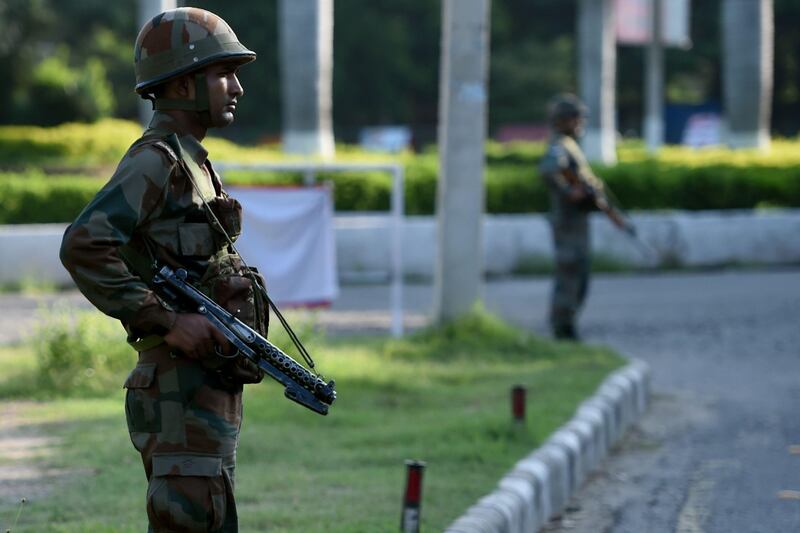One image said it all.
The photo splashed across the front page of the Indian Express newspaper on Saturday showed a mob, rioting after their sect's leader was convicted of rape, chasing a squad of policemen.
The men hold sticks and stones; the policemen are armed and fitted out with riot gear — helmets, armoured vests and protective shields. Even so, they are running away, scrambling over a divider to get to the other side of the road.
The photo captures not only the mayhem in Haryana on Friday that left 30 dead, 250 injured, and property worth millions damaged, but also the abject retreat of the state's authorities in the face of violence that had been fully expected.
Nearly 150,000 followers of the Dera Sacha Sauda — a sect led by the self-styled guru Gurmeet Ram Rahim Singh — had gathered near the courthouse in the town of Panchkula well before it announced its verdict on Friday afternoon.
After Singh was pronounced guilty, his followers went on a rampage, attacking TV broadcast vans, setting buildings on fire, stopping traffic and stoning police. By evening, as smoke rose over the town, the army was called in to restore law and order. Troops had quelled the violence by late Friday night.
There were no outbreaks of violence on Saturday, although the army cordoned off the sect's headquarters in the town of Sirsa in Haryana. About 10,000 of Singh's followers are believed to be in the campus.
The state government's failure to prevent the riots drew criticism from political rivals and even the high court for Punjab and Haryana. "You let Panchkula burn for your political motives," the court said in a statement on Saturday.
The sect's followers had gathered in Panchkula despite the state government banning gatherings five or more people in the town, under a legal provision that is used across India to prevent or quell riots. But the state police failed to enforce the government order.
“Lapses have been identified and we are taking appropriate steps,” the Haryana chief minister, Manohar Lal Khattar, said after the riots erupted. He said the crowd was “a very big mob” that was difficult to control.
Mr Khattar’s office released a statement later claiming that “some anti-social elements [that] got mixed up with the followers of Dera Sacha Sauda … resorted to action and disturbed the peace.”
Rajnath Singh, India’s home minister, also defended Mr Khattar’s handling of the situation, and his government's failure to prevent the sect’s followers from assembling. “In a democracy, how can you stop movement of people altogether?” he said.
However, Mr Singh’s ministry has imposed and effectively implemented the same legal provision used by Mr Khattar's government numerous times. Most recently, it was enforced across parts of Srinagar in Kashmir in June, in anticipation of protests after a civilian was killed by Indian security forces.
Sitaram Yechury, a senior leader of the opposition Communist Party of India (Marxist), suggested the leeway given to the Dera Sacha Sauda followers in Panchkula was because of the close relations between the sect and the Bharatiya Janata Party, the ruling party in Haryana and the federal government.
Mr Yechury said the sect was able to hold Haryana at ransom “solely because the BJP government in the state is in cahoots with it”.
The Dera Sacha Sauda's strong following in Haryana is a valuable asset to politicians seeking votes.
At least three senior ministers in Mr Khattar’s cabinet have made large gifts of money — either personally or through state institutions, to the sect, which is registered as a non-profit.
Ram Bilas Sharma, Haryana’s education minister, granted 5.1 million rupees (Dh300,000) of state funding to the sect earlier this month, ostensibly to help it promote sports education. The cheque was handed to Singh on August 15 during a celebration of his 50th birthday at which he cut a 3,000-kilogram cake.
On Friday, even as the riots were starting in Panchkula, Mr Sharma called the sect’s followers “simple, peace-loving people” who, despite having gathered in large numbers, have “till now … not touched a single plant”.
Prime minister Narendra Modi, who on Twitter called Friday’s violence “deeply distressing,” has praised Singh on numerous occasions in the past. In 2014, seven years after rape charges were first filed against Singh, Mr Modi shared a stage with Singh at a BJP rally in Haryana, ahead of a state election. Mr Modi said he “saluted” Singh or his leadership of his sect.
In turn, Singh called upon his followers at the rally to support the BJP in the election.
Other BJP leaders have spoken up in Singh’s defence even after his conviction for raping two followers in 2002. Subramanian Swamy, a parliamentarian, claimed on Twitter that sending Singh to jail was a part of a political plot to grab his sect’s wealth.
Sakshi Maharaj, another BJP MP, said the verdict was hollow. “Who is right? [Millions] of people who see god in Ram Rahim [Singh] or that girl who filed a complaint?” Mr Maharaj said. “Ram Rahim is a simple man, so he is being harassed.”
Singh, who was flown by helicopter to a jail in the nearby town of Rohtak after his conviction, is to be sentenced on Monday.
_______________________________________________
Read more:
[ Couple separated as Indian authorities look into 'love jihad' conspiracy ]
[ India's supreme court delivers landmark judgment on right to privacy ]
[ End of triple talaq in India ]
__________________________________________________





